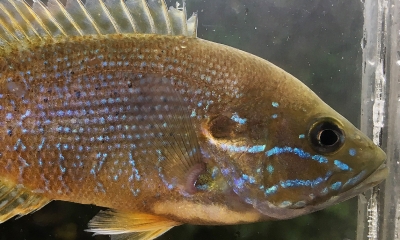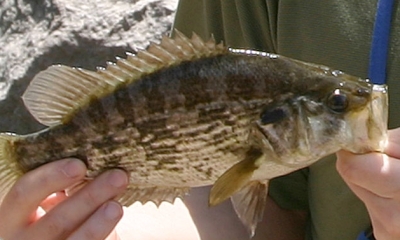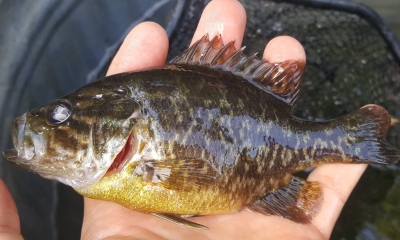
Sunfish
Sunfish is a large group of fish that are well-adpated to life in a pond, lake or reservoir. Many multiply rapidly which can lead to them becoming stunted. But under the right conditions sunfish can grow large enough to be a fun catch and to fill a small frying pan.

Types of Sunfish

Features: Bluegills are distinguished from other panfish by the black ear flap and black spot at the rear base of the dorsal fin. Five to eight greenish, vertical bars are faintly visible on their sides. The body is olive-green in color, bluish above and silvery below. Breeding males develop a bright orange to red flush on the throat area. Adults in most waters measure 5- to 8-inches, but the state record bluegill exceeded 12-inches.
Habitat: Bluegills prosper in clear, clean ponds, lakes and backwaters of slow streams with abundant vegetation. They feed on both plant and animal life, but primarily on small crustaceans, insects, snails and other invertebrates.
Technique: Bluegill are found in many of the lower elevation ponds, lakes, reservoirs and river backwaters throughout the state. Like other sunfish, they generally prefer shallow, warmwater areas with abundant aquatic vegetation and cover. Bluegill are not tough to catch, but you may have to spend time looking for schools of them. Bluegill are best targeted during the late spring when they are spawning and can be found in shallow water where they are highly visible. Look for them in ½- to 6-feet of water in wind-protected areas such as the back ends of coves. Bluegill will often be over sand or gravel bottoms. Spawning begins when the temperature approaches 68 degrees F. At other times of the year find them near weed beds, along drop-offs or around submerged woody debris. Use a bobber rig and size 10, 12, or 14 hook baited with worms, meal worm, crickets, piece of nightcrawler or other natural bait. Bluegill will also readily take small artificial lures such as a jig or tiny spinner, and small wet or dry flies.

Features: Green sunfish have more of a bass-shaped body and a larger mouth than the other sunfishes, other than the warmouth. Also, unlike other sunfish except the warmouth, the pectoral fin is rounded, rather than pointed. Green sunfish are olive green on the back and sides with a yellowish-copper or brassy hue on the lower sides of the belly. Dusky, vertical bars are often present. Turquoise mottling, often in the form of bars, radiates backward from the snout and eye. They have a dark spot at the base of the rear lobe of the dorsal fin.
Habitat: Green sunfish are found in a variety of habitats, from slow streams to shallow lakes or ponds. They are more frequently associated with smallmouth bass than the other sunfish, since they are better adapted to stream life. However, they can also survive in waters too small for most other sunfish. Green sunfish are often found around weed beds because of cover and abundance of food. They feed primarily on aquatic insects.
Technique: Green sunfish are found in many of the lower elevation ponds, lakes, reservoirs and river backwaters throughout the state. In general, green sunfish prefer shallow, warmwater areas with abundant aquatic vegetation and cover. Most are not tough to catch, but you may have to spend time looking for schools of them. Green sunfish are best targeted during the late spring when they are spawning and can be found in shallow water. Look for them in ½ to 6 feet of water in wind-protected areas such as the back ends of coves. They will often be over sand or gravel bottoms where these are available. Spawning begins when the temperature approaches 68 degrees F. At other times of the year find them near weed beds, along drop-offs or around submerged woody debris. Use a bobber rig and size 10 or 12 hook baited with worms, meal worm, crickets, piece of nightcrawler or other natural bait. Green sunfish also readily take small artificial lures such as a jig or tiny spinner, and small wet or dry flies.

Features: Pumpkinseeds may be identified by the orange or red spot on the ear flap and the orange cheeks with wavy blue or turquoise stripes. Color is exceedingly brilliant and somewhat variable; olive to brassy-green above, the back finely dusted with gold or emerald.
Habitat: Pumpkinseeds are found in the same habitats and often in association with bluegills. Adults often congregate beneath old deadheads and trees that have fallen into the water. Food habits are also similar to bluegill. They consume large numbers of snails by browsing on the stalks of aquatic vegetation.
Techniques: Pumpkinseed are found in many of the lower elevation ponds, lakes, reservoirs and river backwaters throughout the state. In general, pumpkinseed prefer shallow, warmwater areas with abundant aquatic vegetation and cover. Most are not tough to catch, but you may have to spend time looking for schools of them. Pumpkinseed are best targeted during the late spring when they are spawning and can be found in shallow water where they are highly visible. Look for them in ½- to 6-feet of water in wind-protected areas such as the back ends of coves. Pumpkinseed will often be over sand or gravel bottoms where these are available. Spawning begins when the temperature approaches 68 degrees F. At other times of the year find them near weed beds, along drop-offs or around submerged woody debris. Use a bobber rig and size 10, 12, or 14 hook baited with worms, meal worm, crickets, piece of nightcrawler or other natural bait. Although rarely exceeding 6 inches, pumpkinseeds will readily bite and are therefore particularly popular with youngsters

Features: Redear sunfish are often confused with bluegill, but differ by having a red or orange border around the black ear flap and by lacking the spot on the dorsal fin and the vertical bars on the side.
Habitat: In Oregon, redear sunfish are found only in a few ponds in the Willamette Valley and the central part of the state. In their native range, redear sunfish prefer warm, large lakes and reservoirs and bayous with vegetated shallow areas and clear water. They feed primarily on the bottom and seldom take surface insects. The diet consists mostly of zooplankton, insect larvae, snails, and other invertebrates. Redear sunfish were introduced in Oregon because they grow rapidly and are not as prone to overpopulate and stunt as the other sunfish.
Techniques: Redear are best targeted during the late spring when they are spawning and can be found in shallow water where they are highly visible. Look for them in ½- to 6-feet of water in wind-protected areas such as the back ends of coves. They will often be over sand or gravel bottoms where these are available. Spawning begins when the temperature approaches 70 degrees F. At other times of the year find them near weed beds, along drop-offs or around submerged woody debris. Use a bobber rig and size 10- or 12-hook baited with worms, meal worm, crickets, piece of nightcrawler or other natural bait. You can also try a bobber and bait or fly rig fished near the bottom. A dark colored wet fly in size 12 or 14 can be effective when fishing for the larger redear sunfish.

Features: Sacramento perch are blackish above with about seven vertical dark bars that are irregular in form and position. They are not a true perch, but a sunfish. It is the only member of the sunfish family native to the west coast and, in Oregon, is found only in the Klamath Basin. Sacramento perch are distinguished from the other sunfish in Oregon by having 12 or 13 dorsal fin spines whereas all the others have 10 or fewer. Maximum size in Oregon is about 12-inches in length and a weight of about 3/4 pound, although in California they have been known to reach a length of 24 inches.
Habitat: Sacramento perch prefer sloughs and slow-flowing streams. Compared with the introduced sunfishes, this species is difficult to catch. However for edibility, it ranks among the best.
Technique: Sacramento perch are best targeted during the late spring when they are spawning and can be found in shallow water where they are highly visible. Look for them in ½- to 6-feet of water in wind-protected areas such as the back ends of coves. They will often be over sand or gravel bottoms where these are available. Spawning begins when the temperature approaches 68 degrees F. At other times of the year find them near weed beds, along drop-offs or around submerged woody debris. Use a bobber rig and size 10 or 12 hook baited with worms, meal worm, crickets, piece of nightcrawler or other natural bait.

Features: Warmouth have more of a bass-shaped body and a larger mouth than the other sunfishes, other than the green sunfish. Warmouth are yellowish brown in color with three or four brownish bars radiating back from the eye over the gill cover. They can be distinguished from the green sunfish by the absence of turquoise mottling on the gill cover and the lack of a dark spot at the rear base of the dorsal fin.
Habitat: In Oregon, warmouth are present in a few coastal lakes and widely distributed in the Columbia basin, but are not commonly caught by anglers. However, they are unusually abundant in Tahkenitch Lake on the central coast. Warmouth are almost always found in shallow, slow-moving or still water where the bottom is soft and there is abundant aquatic vegetation and cover. Young feed on plankton and insects, while adults feed on insects, crayfish and fish.
Technique: Warmouth are best targeted during the late spring when they are spawning and can be found in shallow water. Look for them in ½- to 6-feet of water in wind-protected areas such as the back ends of coves. Warmouth will often be over sand or gravel bottoms where these are available. Spawning begins when the temperature approaches 68 degreesF. At other times of the year find them near weed beds, along drop-offs or around submerged woody debris. Use a bobber rig and size 8, 10, or 12 hook baited with worms, meal worm, crickets, piece of nightcrawler or other natural bait. Worms work best. Warmouth rarely get more than 10-inches long, but are good eating.

